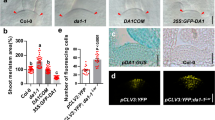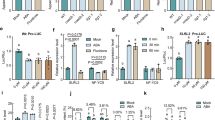Abstract
This work provides some evidences for the saponin production of Panax notoginsenq callus by using biologically active, wall-related oligosaccharins. In an appropriate concentration, three kinds of oligosaccharins stimulated saponin formation or callus growth. The concentration of DO, GO and CO for saponin production of Panax notoqinseng callus culture were 15ppm, 15ppm aud 20ppm respectively by comparing saponin yield. It was very obvious for DO to increase saponin content when the concentration was 10ppm, and for GO to stimulate callus growth when the concentration was 20ppm. It would be a good way to produce saponin by using oligosaccharins in large scale culture in the future.
Similar content being viewed by others
Introduction
Panax notoginseng which belongs to Araliaceae is one of the most famous Chinese rare medicinal herbs and distributed mainly from Yunnan, China. The wild P. notoginseng has not been found for a long time. Cultivation is rather complicated. This makes the cost-effective satisfaction of popular demand difficult. One of the main compounds of pharmaceutical importance in them is saponin as proved by modern chemistry and phamacology.
Oligosaccharins as a new kind of growth regulator have been devoted to much attention in recent years. Zheng and co-workers (1989) studied preliminarily the suspension culture cells of P. notoginseng by using oligosaccharins from Panax ginseng, and proved that oligosaccharins can induce saponin formation 1. We reported here that oligosaccharins from Dendrobium candidum, Cathamus tinctoris and P. ginseng can affect callus growth and saponin content of P. notoginseng, indicating a possibility to produce saponins by using large scale cell culture.
Material and Methods
Experimental material
A good callus strain of P. notoginseng2 was subcultured on MS agar medium 3 at transfer intervals of 30—40 days.
Culture medium and culture conditions
MS medium containing 0.6% agar, 3% sucrose, 10% coconut milk, 2ppm 2, 4-D and 0.1ppm KT was used. The initial pH of the medium was adjusted to 5.8 with 1 mol/L NaOH solution before sterilization. Sterilization was at 120 °C and 1kg/cm2 for 20 min. Small pieces of stock callus were inoculate on 20ml of media in 50ml flasks and cultured at 26±1 °C in the dark for 45 days.
Determination of dry weight (DW) of the callus
The harvested calli were dried up under 50 °C by using a freezing drier2.
Determination of the content of total saponin
A 500—1000mg aliquot of the dried callus powder was soaked in n-butyl alcohol (n-BuOH) for 2 days. Then the mixture was broken for 10 min by using ultrasonic waves. The saponin content was measured by using TLC-colorimetric analysis4 on dry weight basis. The saponin content times yield of callus cultures was saponin yield. Each value was the mean±SE of four replicates.
Preparation and usage of oligosaccharins
Oligosaccharins were acid hydrolysates of young cultured cell walls of D. candidum, P. ginseng and C. tinctoris. The purity of the oligosaccharins was above 98%. In the present experiment, oligosaccharins were also autoclaved together with medium. Studies on chemistry of oligosaccharins will be published in another article.
Results
Effects of oligosaccharins of D. candidum (DO) on callus culture of P. notoginseng
Effects of DO on growth and saponin content of P. notoginseng were shown in Fig. 1. The data indicated that at a concentration range of 5—25ppm, DO had much more pronounced effect on the increase of saponin contont than on callus growth. The saponin contenl was 16.26% which was 51.4% higher than that of the control when DO concentration was 10ppm. The DW of the callus was 0.180g/ flask which was only slightly higher than that of the control (0.135g/flask) when DO concentration was 15ppm. By comparing saponin yield which integraled both callus growth and saponin content, an appropriate DO concentration of 15ppm was found to give in callus culture a saponin yield of 28.24 rag/flask, about 2 fold of that of the control(14.5mg/flask).
Effects of oligosaccharins of P. ginseng (GO) on callus culture of P. notoginseng
Effects of GO on growth and saponin content of P. notoginseng were shown in Fig. 2. The callus growth was obviously stimulated when the GO concentration was 15—25ppm. When GO concentration was 20ppm, the DW of the callus was 0.274g/flask, a value 102.9% higher than that of the control. The saponin content was somewhat increased when the concentration of GO was 5ppm beyond which saponin content of the cultures was found to decrease gradually along with increasing GO concentration. By comparing saponin yield, an appropriate GO concentration to be selectsed was 15ppm, in which saponin yield was 18.83mg/flask, about 29.6% higher than that of the control.
Effects of vligosaccharins of C. tinctoris (CO)on callus culture of P. notoginseng
Fig. 3 showed the results of the effect of CO on callus growth and saponin conSenb of P. notoginseng, both of which were not as marked as those of GO or DO. The saponin formation was slightly stimulated when GO concentration was 5ppm. The callus growth was stimulated when the CO concentration was 15—25ppm. An appropriate concentration was 20ppm, in which saponin yield was 21.25 mg/flask, about 46.6% higher than that of the control.
Discussion
It has been in great demand for the accumulation of secondary metabolites from cultured cells of medicinal plants by adding oligosaccharins, mycelia of fungi, and other factes. we have found that oligosaccharins from the young cultured cell walls have potent biological activities to cultured cells. The effects of the three kinds of oligosaccharins on saponin formation or callus growth of P. notoginseng were very obvious. Different oligosaccharins may have different effects on callus culture of P. notoginseng such as the results shown in Figs. 1, 2, 3. GO was the best one to stimulate callus growth, and DO the best one to increase saponin content of callus. Furthermore, preliminary experiments suggested that GO, DO and CO were effective in inducing an increased accumulation of shikonin in an appropriate concentration 5. We believe that oligosaccharins will play an important role in tissue culture and saponin production of P. notoginseng.
There are still many questions about the physiological mechanism and the mode of action of oligosaccharins on callus culture of P. notoginseng which need to be studied. All investigalions so far have used oligosaccharins prepared in vitro. Natural occurrence of the oligosaccharins, which is a prerequisite for studying natural regulatory role, has been reported only in a few cases 6. The main difficulty facing studies of the natural biologically active oligosaccharins is their low concentration. We agreed with the working hypothesis originally put forward by Fry6 that the walls of living cells contain built-in oligosaccharin units which, in vivo, can be enzymically released from their immobile state into a freely diffusible state. So it is very important to do more basic studies about oligosaccharins with our materials both in vivo and in vitro.
Abbreviations
- DO:
-
oligosaccharins of Dendrobium candidum
- GO:
-
oligosaccharins of Panax ginseng
- CO:
-
oligosaccharins of Cathamus tinctoris
References
Zheng GZ, Wang SL, He JB . Studies on the comparison of cell suspension culture of Panax notoginseng, Panax ginseng and panax qu inque folium. Acta Bot Yunna 1989; 11:97–102
Zheng GZ, Wang SL . Callus culture from Panax notoginseng. Acts Bot Yunnan 1989; 11: 255–262.
Murashige T, Skoog F . A revised medium for rapid growth and bioassays with tobacco tissue culture. Physiol Plant 1962; 64: 473–49I.
Zhang GD, Zhou ZH, Wang MZ, Gao FY . Analyzing in panax ginseng II calculating of ginsenoside. Acta Fharm Sin 1980; 15: 255–262.
Zhou LG, Zheng GZ, Whang SL . Effects of oligosaccharins on pigments of Onosma paniculatum callus. Nat Prod Res Development 1990; 2: 22–26.
Fry SC . In-vivo formation of xyloglucan nonasaccharide: a possible biologica]ly active cell-wall fragment. Planta 1986; 169: 443–453.
Author information
Authors and Affiliations
Rights and permissions
About this article
Cite this article
Zhou, L., Zheng, G., Wang, S. et al. Effects of oligosaccharins on callus growth and saponin content of Panax notoginseng. Cell Res 2, 83–87 (1992). https://doi.org/10.1038/cr.1992.8
Received:
Revised:
Accepted:
Issue Date:
DOI: https://doi.org/10.1038/cr.1992.8
Keywords
This article is cited by
-
Research of Panax spp. in Kunming Institute of Botany, CAS
Natural Products and Bioprospecting (2018)
-
Stimulation of saponin production in Panax ginseng hairy roots by two oligosaccharides from Paris polyphylla var. yunnanensis
Biotechnology Letters (2007)






